#cartiliginous fish
Explore tagged Tumblr posts
Text
Animal of the day for October 29: Great White Shark (Species Carcharodon carcharias)

The largest carnivorous shark, Great Whites travel hundreds of miles every day across the vast ocean in search of food. Great White Sharks have the ability to alternate between warm-blooded and cold-blooded metabolisms (heterothermy), which allows them to survive long periods without eating, or to explore colder waters. This would have likely given Great White Sharks and their kin an edge against other large sharks that existed, such as Alopias grandis or Hemipristis serra.
#animal of the day#october 29#october#great white shark#fish#cartiliginous fish#sharks#pacific ocean#indian ocean#atlantic ocean#southern ocean#australia
56 notes
·
View notes
Text
Animal of the Day for January 9: Goblin Shark (Species Mitsukurina owstoni)

A fairly large shark at... well it says how long it is. Goblin Sharks are, like many deep dwellers, slow-moving predators that eat anything that's edible, and have special adaptations to do so. In the Goblin Shark's case it can thrust its jaws outwards, many fish possess this ability, but the Goblin Shark takes it to extreme levels.
Goblin Sharks are also "living fossils", with the genus Mitsukurina dating back to the Miocene, and closely related genera such as Scapanorhynchus as far back as the Early Cretaceous.
#animal of the day#january 9#january#goblin shark#cartiliginous fish#sharks#fish#pacific ocean#atlantic ocean#indian ocean#sorry no good photos of goblin sharks since they live a thousand meters below sea level
3 notes
·
View notes
Text
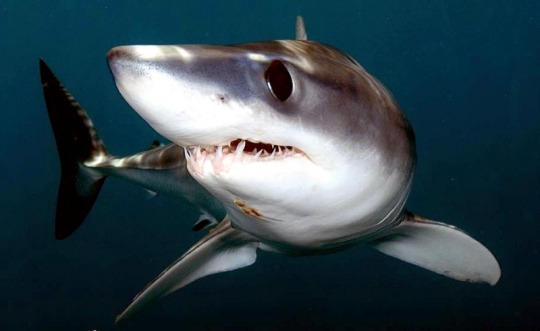
To start off this blog, check out this record-breaking Lamniform! The eyes can be a dead giveaway to who this guy is- the shortfin mako shark (also known as the Isurus Oxyrinchus (scientific name, named in 1810), bonito shark or blue pointer). Found in offshore temperate and tropical waters, the shortfin mako achieved the Guinness World Record on the 18th November 2011 for the fastest shark in the ocean with a top speed of 60 mph! That's as fast as some UK motorways, so don't expect to outswim them if you're on the run from them.
🦈
Quick facts:
Class:Chondrichthyes (jawed, cartiliginous fish and shark)
Subclass:Elasmobranchii
Genus: Isurus
Subdivision: Selachimorpha
Diet: mostly cephalopods (such as squid, octopus and cuttlefish), seabirds, porpoises and bony fish like mackerels, tunas, bonitos and even swordfish. They catch their prey by jumping up and tearing bits from their sides and fins. Makos swim underneath their prey so they can see above and have a good chance of getting to the prey before it sees them.
Lifespan: 29 years (M), 32 years (F)
Long ago, the Māori people in New Zealand wore necklaces and earrings made from shark teeth. The word "Mako" in their language means either "shark" or "shark tooth." Although longfin makos don't live in the waters around New Zealand, shortfin makos do, especially in the northern part of the country.
🔗links ����
Shark Trust (charity): British Sharks | The Shark Trust
2 notes
·
View notes
Text
cartiliginous fish class!!
a wizard is going to turn you into a random animal! whether you like it or not! how nice of them! spin the wheel to find out which class your new species belongs to (and then probably do a google).
27K notes
·
View notes
Text
We are SO sleeping on how weird prehistoric fishes are. Like our legged fish ancestors or armored placoderms like Dunkleosteus are weird in their own way but they have nothing on them
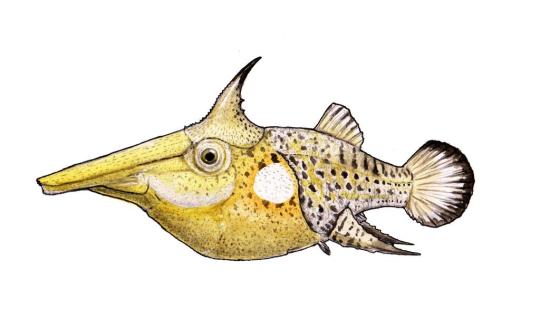
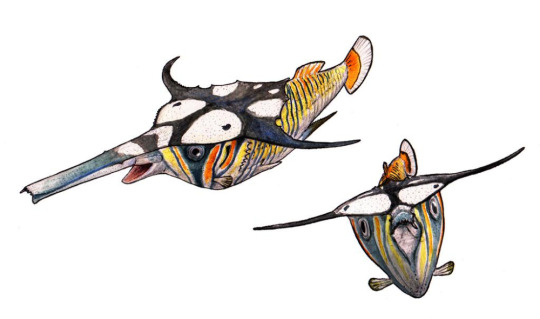
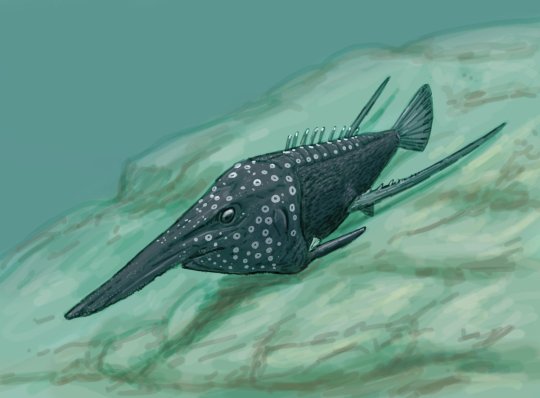

Pycnodonts: literally any body shape they want that uncanny valley except some genera that look like normal trevallies
(Rostropycnodus, Stenoprotome, Gladiopycnodus, Maraldichthys by Joshua Knüppe)

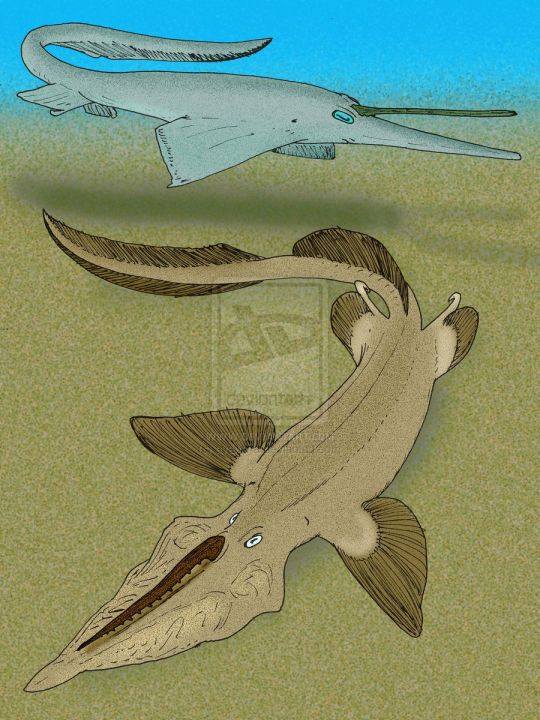
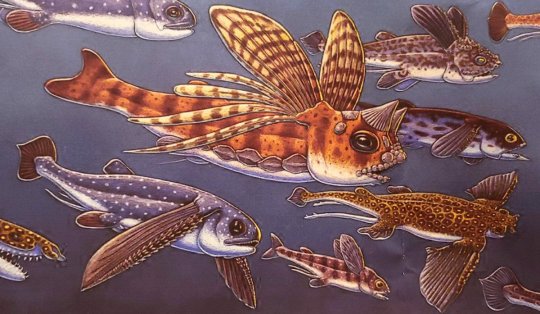
Holocephali: cartiliginous fish closely related to chimaeras, which means they are relatives to sharks.
(Traquairius agkistrocephalus, Belantsea, and Squaloraja by Stanton F. Fink, Iniopterygidae by Ray Troll)
#fish#palaeoblr#palaeoart#joshua knüppe#ray troll#stanton f. fink#pycnodonts#pycnodontiformes#fossil#palaeontology#prehistoric animals#dinosaur#weird animals#holocephali#shark
9K notes
·
View notes
Text
Animal of the Day for December 24: Bonnethead (Species Sphyrna tiburo)

On the smaller end of the scale by shark standards, the Bonnethead is a member of a unique shark family called the Hammerheads (Sphyrnidae), and is unique even among its own kind, being the only known omnivorous shark.
#animal of the day#december 24#december#bonnethead#fish#cartiliginous fish#sharks#pacific ocean#atlantic ocean
3 notes
·
View notes
Text
Legit so many interesting OCs they killed too soon. The weird cartiliginous fish, the sword-nosed dolphins, crocosillians with super specific niches that they look like an ostrich, the weird ass reef fish taht died off. Disappointing.
no earth spoilers please, i’m only up to the cambrian explosion
210K notes
·
View notes
Text
Animal of the Day for November 19: Sand Tiger Shark (Species Carcharias taurus)

These sharks are widespread throughout the Pacific and Atlantic coasts. They look like an underwater demon if you ask me, but they're actually relatively harmless, with no confirmed human fatalities.
Sand Tiger Sharks are nocturnal and are benthic, mostly hunting prey that lives on the sea floor. Baby Sand Tiger Sharks are also cannibalistic, they will eat each other while still inside their mother's womb until only one embryo/fetus remains.
#animal of the day#november 19#november#sand tiger sharks#cartiliginous fish#sharks#fish#pacific ocean#atlantic ocean#mediterranean sea#indian ocean
3 notes
·
View notes
Text
Animal of the Day for January 1: Onchopristis

Despite its appearance, Onchopristis is actually a skate and not a sawfish, though it had the same ecological niche as a sawfish. It was a fairly large animal with the largest specimens likely having been just under 14 feet in length.
Onchopristis would have inhabited a coastal habitat, but would also venture up rivers where it would cross paths with predators such as the famous Spinosaurus.
The type species, Onchopristis numida, is often misspelled as Onchopristis numidus.
#animal of the day#january#january 1#onchopristis#rays#cartiliginous fish#africa#cretaceous#extinct animals#fish
0 notes
Text
Palaeozoic cartiliginous fish. They are weird. The potential we could've seen with 'sharks' occupying traditional bony fish niches.
Pycnodonts are bony fish but they are hella weird too (besides its type species Pycnodus, weirdly). And I also really like basal puffer or triggerfish ancestors they also look really unique.
What are some lesser known cool prehistoric non-reptile marine critters ?
Marine biology is a big special interest of mine but i don't know that much about it in terms of extinct taxa...
148 notes
·
View notes